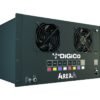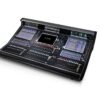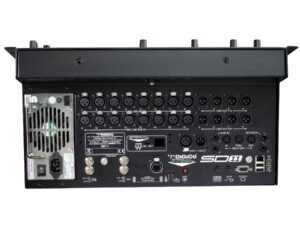DiGiCo SD12 96
DiGiCo SD12 96
Compact in size but big on features, the SD12 96 raises the bar as a multi-application digital console at an exceptionally affordable price point. Not only is the SD12 96 a true sonic powerhouse, it is the first in the SD-Range to feature an integrated recording interface which makes virtual sound checking a snap.
Designed to provide optimum performance in live touring, corporate, install, house of worship, theatre and broadcast environments, the SD12 96 incorporates the latest generation Super FPGA technology and Core 2 software to deliver unrivalled power and connectivity in a compact frame.
Designed for even easier operation, the SD12 96’s new DVI display output provides an overview of the console, while brighter LED meters and a DiGiCo Lightbar ensure optimum
- 96 Input Channels
- 48 Aux / Sub-Group Busses
- LR/LCR Master Bus
- 12 x 8 Full Processing Matrix
- 119 Dynamic Equalizers
- 48/96 kHz Sample Rate
The DiGiCo SD12 shall have 26 faders split into 2 worksurface sections, each with 3 layers of 4 banks, plus 2 master faders. All 26 faders may be assigned to control any of the channel types. The console shall be capable of 72 input channels, 36 Aux/Sub-group Busses, a LR/LCR Master Buss, 12 VCA style or mute group style Control Group channels, 2 Solo Busses, and a 12 input x 8 output full processing Matrix. All processing paths shall have full processing including Tube emulation, Dynamic EQ and Multiband Compression. Tube emulation, Dynamic EQ and Multiband Compression shall be available on every channel and Buss on the console. All processing shall be internal and FPGA-Based. An internal FX rack with 12 stereo slots shall allow users to pick from 34 different FX. An internal set of 16 32-band GEQs shall also be accessible.
Two 15” (38cm) LCD high-resolution touch screens shall be provided to show the channel strips. The right hand screen shall also be able to show the master screen. The view selection of this screen shall be controlled by a physical button on the worksurface. To the left of each screen shall be 7 quick select buttons to allow easy reassignment of the underscreen rotaries, which shall have integrated switches and HTL colour encoded rings. Each screen shall also have a dedicated hardware channel strip, allowing control over filters, EQ, dynamics and insert points. The master section to the right of the console worksurface shall have physical controls to allow control over some snapshot functionsand control over basic Solo functions. There shall also be 5 layers of 5 user-assignable macro buttons and LCDs on the master section of the worksurface. The user shall also be able to program macros that can be triggered with fader movements, GPI, MIDI and keyboard function keys. This master section shall also have a USB port.
The rear panel shall have 8 Mic/Line inputs, 8 line outputs, 4 AES/EBU inputs (8 channels) and 4 AES/EBU outputs (8 channels). It shall also have an inbuilt UB MADI (USB Type B audio I/O interface for recording and playback of up to 48 channels), two sets of BNC MADI I/O for connections to MADI devices, and external Workclock I/O. The other connectors on the rear of the console shall be 1 DSub37 GPI (16 inputs), 1 DSub37 GPO (16 outputs), MIDI In, Thru and Out, 4 USB ports, a DVI port, an ethernet port and an RS422 port. It shall also have 2 DMI slots and 2 redundant power supplies. There shall be an Optocore option, providing either a single or dual loop. Each loop shall give 504 additional audio paths at 48kHz and 96kHz. The Optocore connector type shall be chosen from HMA, OpticalCon or ST. The Optocore Mode shall be chosen from MultiMode or SingleMode. There shall be an optional SD12 96 software extension that provides more channels and more busses, bringing the totals to 96 input channels and 48 Aux/Sub-group Busses
Más productos DiGiCo
Productos relacionados
Digico
Digico
Digico
Digico
Digico
Digico
Digico
Digico













